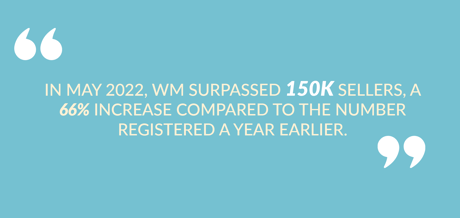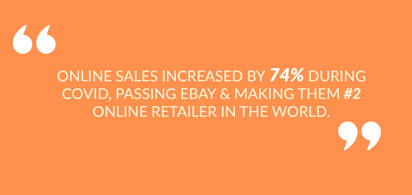Here's 10 Stats You Might Consider to Diversify your E-Commerce
& Gain A New Audience with This Growing Marketplace
Considering selling on Walmart Marketplace? The platform may not be right for all brands. But I believe it's a great platform to reach a new audience. And it's growing at a pace hard to ignore – especially if you want to diversify your e-commerce and not be completely reliant on Amazon and your website.
In this blog post, we'll look at Walmart Marketplace to help you decide if it's right for your food brand.
7 Minute Read
Walmart Marketplace Is Growing
& There's Real Money Behind It
Walmart and Amazon are in constant competition. Walmart leads in retail. Amazon rules online. But Walmart’s big investments in e-commerce means the gap is closing. And that's a potential opportunity for your brand. Think Walmart is just for low-income shoppers? Think again.
Stats Food Brand Sellers Should Know
With COVID in the rear-view mirror, online shopping is the norm. Walmart's online presence, with net e-commerce sales of $73B+, got a huge boost from it. And it continues to grow fast! Becoming a new seller and reaching their new audience isn't really that difficult, especially if you're already on Amazon.
10 WM stats to consider
-
An estimated 220M customers weekly site visitors
-
WM's e-comm revenue +90% from start of COVID-19 to end of January 2022
- Products in 10k+ stores & clubs worldwide
- WM shoppers increasing – especially people working from home
- Their audience have medium to high incomes & own homes
- 30% percent of their online shoppers are ages 23-38
- 50% are married or partnered with children
- Their high-income shoppers are budget conscious & very loyal
- 3rd Party WM sellers in 2016 <10k but by EOY 2021 >130k
- During COVID, they added close to 5k new sellers each month
(Statista)
Download The 2023 Walmart
Marketplace Playbook for Sellers
Walmart Fulfillment Service. Kind of Like Prime
Launched a few years ago, WFS continues building. It gives sellers the option to let Walmart fulfill and ship. In 2021, WFS fulfilled about 25% sales on WM. The basic model is similar to Amazon.
Like Amazon Vendor Central, 1st Party Sellers sell to WM at wholesale and WM sells them online and in stores. 3rd-party sellers, like Amazon, control listings and sell on WM setting prices, inventory, and ship to customers unless they choose WFS. Sellers must apply to sell on WM.
Competition Isn't as Steep As Amazon
The application and selection process reduces competition which is awesome for manufacturer brands. WM is less saturated than Amazon. With so many unscrupulous online sellers on Amazon, this allows exceptional sellers to shine a nice light on their brand.
And then you can build your brand without a deluge of online sellers (as with Amazon) who can freely acquire your product from distributors. On WM, distribution enforcement is way less an issue.
WM's Reputation For Cheap Stuff Has Changed
Their majority of products sell from $10 and $150. But more importantly, their rep has been steadily moving toward value – quality items at a reasonable prices. They maintain strict pricing policies where your sale prices plus shipping must be within their "low price guarantee." Don't be surprised to find super gourmet specialty food products across all categories.
Walmart Marketplace e-commerce
sales grew 17% in Q4 2022
Walmart+ Program. Nowhere near Prime But Growing
At $12.95/mo. or under $100 annually, you get a bunch of benefits including same-day grocery delivery for free ($35 minimum) and free shipping on Walmart.com orders, fuel discounts, and other benefits.
According to Consumer Intelligence Research Partners, they estimate as of January 2022, Walmart+ shoppers made up 25% of total WM customers – some 11.5M members. CNBC had it at 32-50M subscribers since June 2021. Yes, we know this isn't even close to Amazon's 200M Prime members. But that's not really the point here. Consider the audience.
It's obvious Walmart+ was setup to match Amazon Prime. But for you, WM buyer profiles and shopper behaviors are fairly similar.
Over 60% of Amazon buyers says price is the biggest factor in shopping the platform. That value proposition carries itself to WM. And as the competition becomes stronger, Prime members may just be comparing to WM. And with that you may get some switchers in search of the best deal.
Getting Started
So do you think WM might be for you? If you're considering it, remember the basic referral fee is like Amazon. For their Gourmet Food category, you'll pay 15% to WM.
For their Grocery category, it's 8% for items with a total sales price of $10 or less and 15% for items with a total sales price greater than $10. It doesn't cost anything to list, setup your items, or monthly fees compared to Amazon's $39.99 to have a Pro Seller Account

You're Selling on Amazon. How profitable Really are you?
No doubt if you're selling on Amazon, you're reaching its massive 200M+ audience, getting best-in-class FBA Prime service, and taking advantage of a relatively easy to navigate Seller Central platform on the back end.
But on the flip side, their insane customer base has created a competitive firestorm. As a Seller, you need to be super diligent in maintaining competitive pricing. Plus, you'll need to be constantly optimizing your listings to stand out and rank. Their fees are not always easy to navigate - as it'll eat into margins bit by bit. Especially if you're doing Pay Per Click advertising and other programs.
But if you're considering Walmart, keep in mind you can leverage the basic product structure of your storefront. Start by downloading an Amazon Catalog Listing Report. You can get your product data to help prep for a Walmart Feed upload - called a Full Item Spec.
All content you've created in Amazon such as product descriptions, thumbnail images, SKU information including UPC codes, can be used straight away, and prepared for WM. One drawback is WM's seller support. Sellers may find it more cumbersome than Amazon.
Book A Walmart Strategy Call
Summing it up
Amazon is still #1. Maybe they always will be. But WM has experienced exponential growth over the last decade. And COVID gave them a big time boost. Their competitive pricing policies for sellers, the offer of free shipping, and different avenues for selling make it the perfect place to expand your brand and sell more products.
Ultimately, the best platform for your business depends on your specific needs and goals. But between you and me and the lamppost, I think WM is just too enticing to pass off. And why not grow a new audience? If you think you want to go for it, reach out. We can help.
Happy Walmart Marketplace Selling!
Lou
Lou Nicolaides
lou@ludwigmarketingandsales.com
(626) 703-4592




